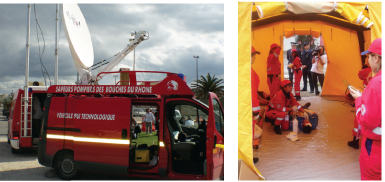The risk of epidemics and emerging or re-emerging diseases is rising and can only be contained with prevention, early warning and prompt management. Readiness exercises are critical in improving readiness, in testing means, methods, master plans and procedures, and above all in training civil protection personnel.
The SAFE (Satellites For Epidemiology) project is co-funded by the European Space Agency (ESA) and coordinated by MEDES (FRANCE). In a two-day earthquake readiness exercise that was held on the island of Crete, Greece, on November 5-6, 2007, it demonstrated a component-based system for health early warning. The exercise that was coordinated by the Prefecture of Heraklion and FORTH-ICS, involved around 300 people from more than twenty organizations. Observers from ESA, the World Health Organization (WHO), the European Center for Disease Control (ECDC) and other organizations assessed the added value of satellite-enabled services not only in the acute phase following the disaster but also in post-disaster health management and epidemiological surveillance.
On the first day, the exercise scenarios covered search and rescue operations in a power plant and a large hotel complex, as well as averting pollution and environmental disaster after a fuel leakage. The SAFE van offered satellite communication and deployed a WiFi network in the crisis area. Volunteers of the Hellenic Red Cross used triage protocols available in handhelds connected to the emergency coordination system and a central hospital. A WiFi camera conveyed sights and sounds of the disaster to decision makers in the operations centre.
On the second day, epidemiology scenarios of post-disaster health management unfolded in a refugee camp coordinated by the Hellenic Red Cross and the Prefecture of Heraklion. Upon arrival, the state of health and the medication needs of refugees were recorded in a primary care Electronic Health Record (EHR) system that was extended to support rapid data entry of health problems and medication using Personal Digital Assistants (PDAs). Summary reports that reflected the overall status and health needs of the camp were then automatically generated.
Soon afterwards, the first signs of a Salmonella enteritidis outbreak appeared in the camp. Suspicious cases of gastroenteritis raised an alert in the epidemiological surveillance system and triggered investigation. In collaboration with experts, an epidemiological protocol was tailored and promptly deployed to the PDAs of the data collection team. Decision makers followed the progress of the investigation online, using the Web version of the SAFE data collection system. Water sources were shown in the Geographic Information System (GIS) via a dedicated layer and the relevant risk was assessed. As biological samples were analysed in the mobile laboratory, expert centres provided remote support in laboratory analysis and interpretation based on images transmitted via satellite. A tourist with Salmonella typhi was identified and the health alert was communicated internationally to ECDC and WHO by the Early Warning and Response System (EWRS) via the Center for Disease Control (KEEL PMO) and the Center of Emergency Operations in the Hellenic Ministry of Health.

The exercise proved that ICT can assist in rapidly assessing an epidemiological situation and taking appropriate measures. Decision makers were able to track the progress of the epidemiological investigation online, while data mining and statistical analysis identified water from a tank as the most likely cause of the epidemic before the laboratory results were available!
SAFE succeeded in successfully employing satellite, radio and wireless networks, geographic information systems, integration technology and data mining to promptly identify and respond to a disease outbreak.
Satellite communication can augment the overloaded telecommunication infrastructure, thereby providing connectivity to remote and inaccessible areas at short notice and contributing to better coordination and clearer assessment of the crisis. The time required to set up satellite connectivity turned out to be quite short. However, in disaster situations connectivity can be unpredictable and is affected by location and weather conditions. The ability of the SAFE system to operate in disconnected mode turned out to be a critical advantage.
The effective use of ICT in disaster situations, real or 'simulated', requires organizational changes and targeted staff training. At the same time, ICT usability in disaster and post-disaster management is a major issue. Online services need to be simple, flexible and streamlined, taking advantage of different forms of connectivity in a cost-aware fashion. As a consequence, satellite-enabled services need to be refined, adapted and extensively tested in the context of readiness exercises to improve our capacity to issue health early warning and promptly manage outbreaks.
Security and confidentiality are further major issues that can be a source of inefficiencies in the presence of intermittent connectivity if password-based authentication is required.
Technical interoperability and integration of the different systems involved is a key requirement for the seamless support of streamlined workflows when time is critical. The HL7 Clinical Document Architecture and Arden Syntax are vital tools that should be further investigated as part of our future work for seamless service integration.
The exercise identified significant strengths as well as weaknesses that need to be addressed in health early warning systems for public health. At the same time, participants and observers recognized that SAFE offers valuable tools to the 'Epidemic Intelligence' and paves the way towards advanced preparedness and response by lifting communication barriers, promoting collaboration and reducing the isolation of affected areas.
FORTH-ICS coordinated the SAFE demonstration in close collaboration with local authorities, MEDES, France (project coordinator); GMV, Spain; TTSA, France; REMIFOR, France; and medical experts from the University of Verona and the University of Crete. Institutes of epidemiology in Spain (ISCIII-CNE) and France (InVS) ensured compliance with the practices and policies of epidemiological monitoring.
Links:
ICS-FORTH: http://www.ics.forth.gr
SAFE project: http://www.medes.fr/safe
Institute for Space Medicine and Physiology, MEDES-IMPS: http://www.medes.fr
European Space Agency: http://www.esa.int
SAFE exercise video: http://www.esa.int/esaTE/SEM7DK73R8F_index_0.html
European Center for Disease Control: http://www.ecdc.europa.eu/
Early Warning and Response System: https://ewrs.ecdc.europa.eu/
World Health Organization: http://www.who.int
Please contact:
Audrey Berthier
MEDES, France (project coordinator):
E-mail: audrey.berthier![]() medes.fr
medes.fr
Catherine Chronaki
FORTH-ICS, Greece
E-mail: chronaki![]() ics.forth.gr
ics.forth.gr










